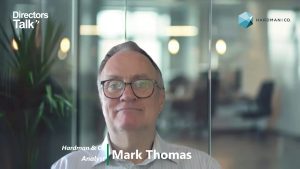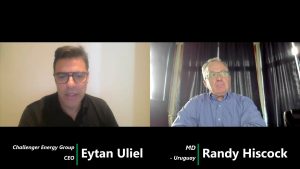Powerhouse Energy Group PLC (LON:PHE) Chief Executive Officer Keith Allaun caught up with DirectorsTalk for an exclusive interview to discuss their full year business update
Keith, good to talk to you again.
Thanks very much Giles, it’s great to be here at DirectorsTalk again. I just want to make a quick correction and as was announced in our recent year-end update of progress this last year, we were fortunate enough to be able to appoint Dr Cameron Davies as Non-Executive Chairman of the Board for the company. Dr Davies brings a wealth of experience and city knowledge and most importantly, an entrepreneurial zeal to our Board and really to act as a mentor to management as we move forward. That said, I’m excited to be here, I’m now the CEO, I’m able to focus 100% of my time on truly the operational and strategic issues surrounding the company and moving the company to its next stage of commerciality.
Q1: We saw that you released a full-year business update, I’ll come to that shortly. For now, and for those that don’t really know, can you explain for us what it is that Powerhouse Energy do?
A1: Powerhouse is actually the pioneer in the hydrogen from waste generation market that is a burgeoning market in the UK. So, our process of ultra-high temperature gasification allows us to convert any high calorific value things, like plastics or used tyres. Over 500,000 tonnes of plastics were exported from the UK last year to China or used tyres where there is one end of life tyre per man, woman and child in the entire United Kingdom generated every year. So, we can take feedstocks like that that have historically been very difficult or have been things that we have shipped off shore and we can extract 95% of the energy value from those materials and convert that into a stream of road-quality, ultra-high purity hydrogen.
Q2: Just going back to the update, what were the key points that were made?
A2: Really, 2017 was about the maturity of the company, over the past couple of years as we have been building out the G3-UHt unit, our ultra-high temperature gasification unit, a lot of that work has been done in Australia. We migrated that work from Australia into the UK with the full knowledge that we’re a UK-listed company under the symbol PHE and we’re going to be operating here in the UK because there’s a significant demand for both waste eradication and landfill diversion and, as we can talk about later, the generation of distributed hydrogen that can be used as a road fuel.
So, 2017 was about bringing the equipment, the technology, into the UK, testing it, setting up at the Thornton Science Park near the Peel Protos operation near Chester, in the North-West. Ultimately, building relationships with a variety of potential partners, both from an engineering perspective, from a project development perspective and then of course expanding our investor base.
The other significant accomplishment of the year was, of course, the appointment of Dr Davies and the retirement of the Hillgrove convertible note that was causing quite a drain on the company’s capital.
So, I think that we’ve made substantial progress and in fact, I think the last RNS that we released in 2017 was the identification of the site for our first commercial facility which will be up in the North-West, near Chester. We are in the final phases of that process with Peel Environmental and so, we’re engaged in the surveying and the early-site design for our first commercial operation up there which will be fully demonstrating, in a commercial manner, the ultra-high temperature gasification and the production of hydrogen.
Q3: Bringing a product like this to the market, the timing really couldn’t get much better, could it?
A3: You’re spot on there, Giles. I think that we’ll look back on 2018 in 5 years from now as really the year that the hydrogen economy door started opening. When one looks at the literally billions of pounds that are being invested by manor transportation companies like Toyota, Hyundai, Mercedes, BMW, not just in hydrogen fuel cells cars, because they recognise the substantive value proposition that a hydrogen fuel cell vehicle represents over traditional electric vehicles and lithium-ion battery technology.
They’re also investing in infrastructure around hydrogen because hydrogen as a fuel is the cleanest fuel that exists on Earth, there is no residue, you’re left with water vapour, upon the utilisation of hydrogen it converts into H2O in the creation of electricity in a hydrogen fuel cell.
So, the value proposition, there’s a confluent that exists around the hydrogen economy and then additionally, as one starts to look at the fact that we’ve really reached an inflection point, we reached a tipping point around the scourge that plastics and end of life tyres represent to our ecology.
The dramatic attention that’s being paid to the fact that 8 million tonnes of plastics is being dumped into the oceans ever year and that micro-plastics, a flotilla of plastics the size of Mexico, a flotilla the size of the country of Mexica was discovered off the coast of Chile by National Geographic research expedition last year. We’re realising that we’re poisoning our oceans which is a harbinger of a horrific future unless we stop that.
We believe that the Powerhouse Energy technology, our ability to engage in distributed modular gasification, allows us to take our solution to the point of where the problem exists. To gasify the plastic waste stream or those end of life tyres and extract the hydrogen value, extract 95% of the energy value out of that feedstock and turn it into something useful for the UK, the EU, the Far East and the rest of the world.
So, we feel like the time is right, we have been really educating people about the advent of the hydrogen economy for over a year now, but we know that the time is right. We know the time is right because frankly, people much bigger than us are making significant investments, as I said, and major engineering companies are now investing in the application of hydrogen fuel as an additive to marine transport. Industrial transport manufacturers, people who are making heavy-duty trucks and lorries are investing in either fully hydrogen fuel cell vehicles or hydrogen-diesel fuel vehicles that dramatically reduce the particulate matter out of the diesel vehicle and dramatically reduce the Co2 emissions of diesel vehicles.
The final thing that I think’s important to recognise is that the mechanism by which we’re generating hydrogen is effectively greenhouse gas free. The conventional method by which hydrogen is produced is a process called steam methane reformation, or SMR, and SMR generates between 12-16 tonnes of Co2 for every tonne of hydrogen that’s generated. Our process generates almost no Co2, literally orders a magnitude less Co2 in the gasification process from which we can extract a 99.999% pure stream of hydrogen.
So, for the hydrogen economy to truly take off and for us to have a significant impact on global climate change and global warming and the health of our oceans coupled with the fact that this is going to be the fuel of the future, we could not be in a better place.
Q4: In your comment, you said you remain confident that hydrogen from waste plastic will emerge as the preferred fuel for road transport, why do you think it is?
A4: I look at the fact that China just said to the UK we’re beginning to see we’re no longer accepting the 500,000 tonnes of plastics that you had been shipping to us for elimination, for either recycling or incineration, because we’re moving away from incineration. I was reading a report yesterday, there is not the recycling infrastructure in existence in the UK to handle all the waste plastic that exists, the Thames Estuary is inundated with plastic residues.
What it appears the government has been looking at as a stop-gap measure is if China’s not going to take our plastic waste, let’s find someone else who is willing to take our plastic waste. A large component of the plastic waste stream is non-recyclable, the recyclables should be recycled, there’s no question about it, we’re huge advocates for recycling and reuse but a large component of everything that we do is single-use plastic that cannot be recycled. We cannot simply send this off to landfill and incineration is a technology whose time has come and gone, we can no longer invest in £300 million incinerators that are extracting a miniscule portion of the economic value of the resource that they’re using which is refuse.
We, on the other hand, can extract 95% of the energy value of that very same plastic from which an incinerator is only extracting 28% and so, the opportunity for us to take that resource that’s been shipped off shore, we’re effectively giving money away to other countries by sending them our plastic residue. That plastic residue alone, through our process, could generate enough hydrogen to fuel 120,000 hydrogen fuel cell vehicles every day of the year for a year so the reality is the use of end of life tyres for which we’ve been struggling for 50 years to figure out what to do with end of life tyres, we know what to do with them.
We can now absolutely thermally decouple them from their hydrogen, collect the hydrogen, collect the carbon, have a significant impact on the environment in a positive way, have a significant economic impact by virtue of the fact that we’re creating a fuel for which there is absolutely massively growing demand. The compounded annual growth rate of hydrogen fuel cell vehicles is currently estimated to be somewhere in the neighbourhood of 26% per annum over just the next 6 years and it’s only going to accelerate from there.
We are at the inflection point which the door to the hydrogen economy has opened and people who want to be part of the hydrogen economy should be engaged with Powerhouse Energy Group because we’re the train that’s going to take us there.
Q5: Finally, from an investors point of view, what’s next for Powerhouse Energy? What are the next steps? What should we be looking for?
A5: We have begun the process of the site works and the site design for our first commercial facility coupled with the fact we’re finalising the final stages of the commercial engineering design for the facility. Next on the agenda is going to be really the ordering of components, the building of proprietary components and really the pulling together of the very first DMG, Distributed Modular Gasification system, that’s going to be operating in the North-West with the support of the North-West hydrogen hub and Chester University.
So, next on the agenda is getting our first commercial facility out there with the intention of following up with exponential growth thereafter. Our intention is not to have 1 or 2 plants, keep in mind that we’ve created this philosophy of Distributed Modular Gasification, creating small footprint facilities that can operate anywhere and everywhere without harmful emissions to the environment and that can solve the problem, where the problem exists.
We can create a hydrogen fuelling station in a community, utilising the waste generated by that community and this is not something that has to be sited miles out of town, this is something that could literally be sited next door. Again, small footprint, roll out multiple fuelling stations for the advent of the hydrogen economy.











































